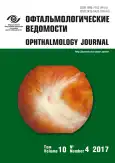Clinical care of acanthamoeba keratitis patients
- Authors: Skryabina Y.V.1, Astakhov Y.S.2, Konenkova Y.S.1, Varganova T.S.1, Petukhov V.P.1, Nokhrina K.V.3, Dnestryanskaya K.O.3
-
Affiliations:
- City multifield hospital No. 2
- Academician I.P. Pavlov First St. Petersburg State Medical University
- I.I. Mechnikov North-West State Medical University
- Issue: Vol 10, No 4 (2017)
- Pages: 24-31
- Section: Articles
- URL: https://journals.rcsi.science/ov/article/view/7785
- DOI: https://doi.org/10.17816/OV10424-31
- ID: 7785
Cite item
Abstract
Recently, akanthamoeba keratitis (AK) is seen more and more often in ophthalmological practice. However, today there are no standard guidelines concerning diagnosis and treatment of patients with AK. In the article, the experience in care for such patients is presented.
Purpose: to estimate the efficiency of diagnosis and treatment of patients with AK.
Materials and methods. Case histories of patients, who received treatment for akanthamoeba keratitis in the Eye Microsurgery Department No. 4, City Ophthalmologic Center of the City Hospital No. 2, from 2011 to 2016, were analyzed. Under observation, there were 25 patients (26 eyes) with akanthamoeba keratitis aged from 18 to 77 years; there were 15 men and 10 women. Patients were observed during 1 year. Full ophthalmologic examination was conducted in all patients. Additional diagnostic methods included microbiological investigation of corneal scrapes and washings, culturing them on innutritious agar (with E. сoli covering), confocal corneal microscopy (HRT 3 with cornea module, Heidelberg Retina Tomograph Rostock Cornea Module). A superficial punctate keratits (AK stage 2) was found in one patient. All other patients were divided into two groups. Stromal ring-shaped keratitis was diagnosed in patients of the first group (7 patients, AK stage 3). The 2nd group consisted of 17 patients with corneal ulcer (AK stage 4). All patients received medicamentous treatment. However patients of the 2nd group required different kinds of surgical treatment.
Results. In AK diagnosis, corneal confocal microscopy is the most informative method. In patients with AK stages 2 and 3, there was an improvement in visual functions as a result of medicamentous therapy. As a result of treatment at the discharge from the hospital, the best corrected visual acuity was 0.5-1.0 for most patients. In the 2nd group patients, who were subjects to different types of surgical treatment visual functions stabilized. However non-compliance with recommendations led to disease recurrences with worse outcomes in four cases.
Conclusion. It is possible to stop the inflammatory process preserving at the same time high visual functions only when patients are addressed in time, and when appropriate AK therapy is prescribed and patients are compliant with it for a long time.
Full Text
##article.viewOnOriginalSite##About the authors
Yelena V. Skryabina
City multifield hospital No. 2
Author for correspondence.
Email: Scryabelena@mail.ru
MD. Microsurgery department No. 4
Russian Federation, Saint PetersburgYuriy S. Astakhov
Academician I.P. Pavlov First St. Petersburg State Medical University
Email: astakhov73@mail.ru
MD, PhD, DMedSc, professor
Russian Federation, Saint PetersburgYanina S. Konenkova
City multifield hospital No. 2
Email: Krokon@mail.ru
MD. Microsurgery department No. 4
Russian Federation, Saint PetersburgTatiana S. Varganova
City multifield hospital No. 2
Email: varganova.ts@yandex.ru
MD, candidate of medical sciences, ophthalmologist, consultative-diagnostic department of ophthalmology
Russian Federation, Saint PetersburgVladimir P. Petukhov
City multifield hospital No. 2
Email: v.p.petukhov@gmail.com
MD, ophtalmologist, department of laser microsurgery
Russian Federation, Saint PetersburgKseniya V. Nokhrina
I.I. Mechnikov North-West State Medical University
Email: noxrinak@mail.ru
second year ophthalmology resident
Russian Federation, Saint PetersburgKaleriya O. Dnestryanskaya
I.I. Mechnikov North-West State Medical University
Email: kaleria39@mail.ru
second year ophthalmology resident
Russian Federation, Saint PetersburgReferences
- Обрубов А.С., Слонимский А.Ю. Оптимизация тактики ведения пациентов с кератитами и гнойными язвами роговицы, связанных с ношением контактных линз // Невские горизонты-2016: Материалы научной конференции офтальмологов / СПбГПМУ. – СПб.: Политехника-сервис, 2016. – 518 с. [Obrubov AS, Slonimskij AJu. Optimizacija taktiki vedenija pacientov s keratitami i gnojnymi jazvami rogovicy, svjazannyh s nosheniem kontaktnyh linz. Nevskie gorizonty-2016: Materialy nauchnoj konferencii oftal'mologov (Сonference proceedings). Saint Petersburg: Politehnika-servis; 2016. 518 p. (In Russ.)]
- Околов И.Н., Чайка Н.А., Егорова О.В., и др. Акантамёбы и акантамёбный кератит: Пособие для врачей. – СПб., 2005. [Okolov IN, Chajka NA, Egorova OV, et al. Akantameby i akantamebnyj keratit: Posobie dlja vrachej. Saint Petersburg; 2005. (In Russ.)]
- Ян А.В., Жоголев К.С., Кутик Д.С., Кузнецов А.Р. Диодные лазеры среднего ИК-диапазона: возможности лечения бактериальных язв роговицы // IX съезд офтальмологов России. Воспалительные, инфекционные и аллергические заболевания глаз. – М., 2010. [Jan AV, Zhogolev KS, Kutik DS, Kuznecov AR. Diodnye lazery srednego IK-diapazona: vozmozhnosti lechenija bakterial'nyh jazv rogovicy. IX s#ezd oftal'mologov Rossii. Vospalitel'nye, infekcionnye i allergicheskie zabolevanija glaz. (Сonference proceedings) Moscow; 2010. (In Russ.)]
- Page MA, Mathers WD. Acanthamoeba Keratitis: A 12-Year Experience Covering a Wide Spectrum of Presentations, Diagnoses, and Outcomes. Journal of Ophthalmology. 2013. Article ID 670242, 6 pages. doi: 10.1155/2013/670242.
Supplementary files












